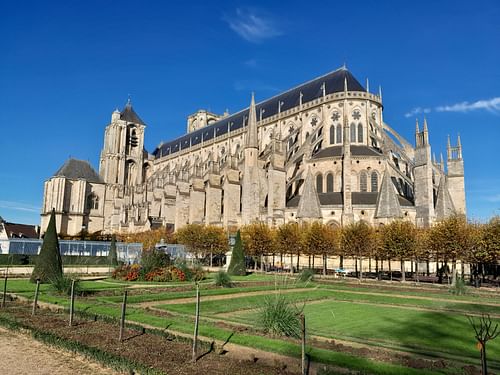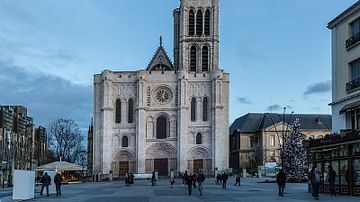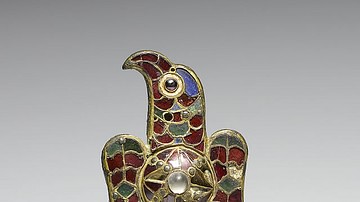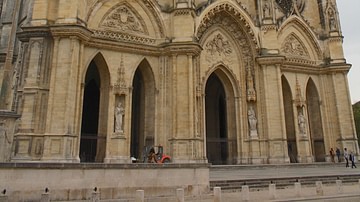
Bourges Cathedral, dedicated to Saint Stephen, is a Gothic cathedral located in Bourges, Le Cher, central France. Built from 1195 to 1245, the cathedral is one of the largest in Europe and contains many magnificent stained glass windows which date to the 13th century. Bourges Cathedral is listed by UNESCO as a World Heritage Site.
Renewal & Expansion
Legend has it that today's cathedral is situated on the spot Saint Ursinus founded a church in the 3rd century. More certain is the existence of a Romanesque cathedral at the site from the 11th century, credited to the efforts of Archbishop Gauzlin (1013-1030). This church was expanded in the mid-12th century under the guidance of Archbishop Pierre de La Châtre (1141-1171). Exterior architectural elements and sculptures of this later version were reused in the present Gothic cathedral. By the final decade of the 12th century, the Romanesque cathedral became too small for the city's needs, now the centre of an expanded diocese, and so the people of Bourges began plans to build a new cathedral in the High Gothic style, the first such edifice in France south of the Loire river.
The project, guided by Archbishop Henri de Sully (1183-99) and funded both by his own large donation and collectors who knocked on doors for donations across the entire region, was certainly an ambitious one, especially so for a church with, as yet, no sacred relics of its own or a place on the pilgrimage trails that crisscrossed Europe. The name of the master architect who designed the building is not known for certain. Construction got underway from 1295, and after 1299, the project came under the supervision of Guillaume du Donjon. It was this former Cistercian abbot who managed to raise more much-needed funds for the project by acquiring a number of prestigious relics, amongst them the jawbone of Saint Stephen (in French, St. Étienne). Donations from visitors who came to see such relics were a great boost to the decades-long building project. Guillaume du Donjon died in 1209, and he was subsequently made a saint for his efforts in giving Bourges its great cathedral; his remains now lie behind the choir.
By 1215, the cathedral was taking shape and ready to receive its stained glass windows, but for some reason – most likely a lack of finances and the architectural problem of just how to incorporate the Romanesque portals into the new structure – the great project stalled for a decade. There had also been some protests from the Cistercian monks of Loroy whose forests had been seriously depleted in the search for timber for the construction project. Work eventually began again in 1225 but was limited in progress due to costs. Nevertheless, the building work kept going, albeit slowly, so that it was not until around 1245 that the cathedral could be described as being more or less finished. The towers still needed extensions and the exterior sculptures were added as they came along. There were setbacks, too, notably a fire in 1259 and the appearance of worrying cracks in the vaulting as the foundations struggled to support the massive weight of masonry. Various running repairs were conducted over the following decades. A plan to add bells to the towers was scrapped as too risky, and so they became known as "tours sourdes" or "deaf towers". Finally, on 5 May 1324, the cathedral was officially dedicated to Saint Stephen. In April 1422, the future Charles VII of France (r. 1422-1461) married Marie d'Anjou in the cathedral.
The cathedral continued to receive additions over the years, such as windows in the main façade, but disaster struck on 31 December 1506 when the North Tower collapsed, as many had feared it would for two centuries. Rebuilt over the next 50 years, the new North Tower was built, and at 65 metres (213 ft), it was much higher than the old one. Finally, the tower was given its bells. Since the 16th century, the cathedral has withstood further misfortune and attacks ranging from Huguenot vandals to tasteless architects. Restoration work began in the 19th century and, as with all such large buildings, continues today as a never-ending process.
Exterior
Bourges cathedral is a massive example of its type. The total length of the structure is 125 metres (410 ft) long. The width of the building including its buttresses is 73.45 metres (241 ft). The asymmetrical look of the façade with its towers of unequal height is explained by the collapse and rebuilding mentioned above (the smaller South Tower reaches a height of 53 metres or 173 feet). The North Tower can be climbed today if the visitor is up to the challenge of its 396 steps. Between the two towers is the great rose window known as the "Grand Housteau" which sits above six lancet windows. The flanks of the cathedral are dominated by the flying buttresses on two levels, but these are enlivened by the many windows of the cathedral between each support structure. The height of the roof of the nave is 55 metres or 180 feet.

The western façade of the cathedral has five impressive portals or doorways. The central portal is the largest, but all five carry a great mass of sculpture work. The figure sculptures on the central portal represent the Last Judgement and date to around 1240. The dead are shown climbing out of their coffins, and those who are destined to be saved or damned are then separated; particularly striking is the scene on the far right showing devils throwing struggling humans into a massive cauldron heated from beneath by roaring flames. There are even two devils gleefully using bellows to increase the intensity of the fires of hell.
Another interesting sculpture group is the portal showing the life of Saint Stephen. The other three portals show the life of Saint Ursinus, the Virgin Mary, and Saint William (the latter two sculpture groups are a restoration project carried out around 1510). There is even a place for the legendary founder of the first church on the site, Saint Ursinus, depicted next to a miniature version of the cathedral.
The sides of all of the portals carry larger figures depicting the Old Testament prophets and the Apostles. The arches of the portals have smaller figures carved into them (four rows in the smaller portals and six over the central one), and these represent angels, martyrs, confessors, and saints. All of the exterior figure sculpture was originally painted in various colours.

Interior
The large interior is given a sense of openness by a distinctive feature of Bourges cathedral: the absence of a transept, a feature (the Latin cross plan) present in most Gothic cathedrals. The basilica design has five naves. The total length of the interior space is 117 metres (383 ft) and the width is 41 metres (134 ft). The great height of the interior is permitted by the combination of ribbed vaults in the ceiling and a double row of massive flying buttresses outside supporting the walls and towers. Another contribution to the openness of the interior is the use of windows at all levels.
The interior space is dominated by the two rows of giant columns supporting the ceiling composed of a series of sexpartite vaults. These columns are well over two metres (6.5 ft) in diameter and 19 metres (62 ft) in height. The height of the ceiling is 36 metres (118 ft). There are 13 chapels along the sides of the cathedral, six on the southern side and seven on the northern side. The largest chapel is the Sacred Heart chapel (on the immediate left as one enters the southern portal entrance) which shows the arms of the dukes of Berry, the historical province of which Bourges is still the capital. The other chapels, built across the 14th to 16th centuries, were funded by wealthy local families. Many of these chapels have their own stained glass windows.

At the back of the principal nave is the great organ encased in a sculptured oak covering. This casing was made around 1663, but the present organ inside it was installed in 1985; it has over 3,500 pipes covering 50 registers. Other points of interest include the crypt, which is a survivor from the 11th-century Romanesque cathedral. In the crypt is the tomb of Jean de Berry (aka John, Duke of Berry, 1340-1416). Sculptural elements also survive of the cathedral's 13th-century rood screen. Finally, the astronomical clock was made in 1424 and is the oldest such example in France that retains its original aspect.
The Stained Glass Windows
The cathedral's dazzling array of stained glass windows, many of which date to the first decades of the 13th century, show all manner of Bible stories. As the cost of many windows was provided as a donation by the various guilds of the city, they often show scenes relevant to the donators such as furriers, bakers, butchers, cartwrights, masons, and various merchants. Typically seen in the scenes at the base of a window, artisans are shown at their daily work and are a useful insight into the tools and methods used in the Middle Ages. The main group of stained glass windows is around the semicircle of the ambulatory. These tall windows show a variety of styles of geometric compartments, some have circles, others stars or multifoils. The windows tell in multiple scenes familiar biblical episodes and parables. The windows should be 'read' by starting at the bottom panels and working up in rows to the top.

Starting from the right side of the ambulatory, the subject matter of each window is as follows:
I: The Life of Joseph the patriarch (with chapel windows showing the lives of Saint John the Evangelist, Saint John the Baptist, and James the Great)
II: Saint Thomas in the Indies
III: The Apocalypse (with chapel windows on the lives of the saint-deacons Vincent, Étienne, and Laurent)
IV: The Passion of Christ
V: The Last Judgement
VI: The New Alliance
VII: The Prodigal Son (with chapel windows on the lives of Saint Martin, Saint Peter, Saint Paul, and Saint Denis)
VIII: The Good Samaritan – unusually, this window is 'read' top-down (with chapel windows on the lives of Saint Mary Magdalene, Saint Nicholas, and Saint Mary the Egyptian)
IX: The Relics of Saint Stephen
X: Lazarus and the Bad Rich Man
In 1992, UNESCO listed Bourges Cathedral as a World Heritage Site. The building qualified for the prestigious list because of its "considerable importance in the development of Gothic architecture and as a symbol of the strength of Christianity in medieval France. However, its principal claim lies in its striking beauty, combining masterly management of space with harmonious proportions and decoration of the highest quality" (UNESCO).






